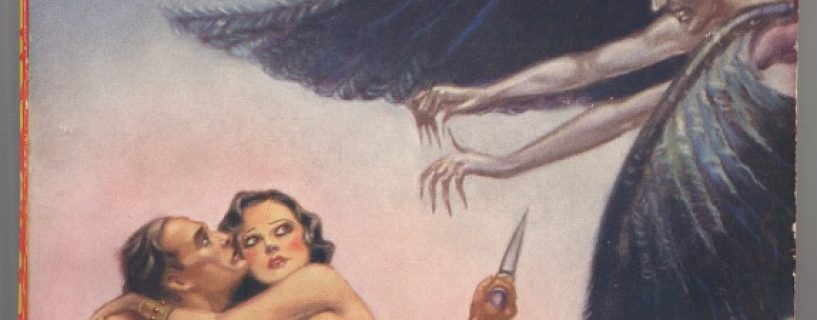Know, O prince, that between the years when the oceans drank Atlantis and the gleaming cities, and the years of the rise of the Sons of Aryas, there was an Age undreamed of, when shining kingdoms lay spread across the world like blue mantles beneath the stars – Nemedia, Ophir, Brythunia, Hyperborea, Zamora with its dark-haired women and towers of spider-haunted mystery, Zingara with its chivalry, Koth that bordered on the pastoral lands of Shem, Stygia with its shadow-guarded tombs, Hyrkania whose riders wore steel and silk and gold. But the proudest kingdom of the world was Aquilonia, reigning supreme in the dreaming west.
-Nemedian Chronicles, Robert E. Howard
If you like Penny Dreadfuls, Dime Novels you like the predecessors of what many come to know as Pulp Magazines. This genre of story and entertainment would grace the earth from the years 1896 through the 1950s. It was what some considered the precursor to the rise of comics and the superhero genre and much more. So its important to understand how modern media and storytelling was influenced by the Penny a word writing by the likes of HP Lovecraft, Robert Howard, and Edgar Rice Burroughs. But first lets acknowledge a few things. This period of time while holding fantastical stories are still problematic in the modern times. Three writers I’ve listed have several issues that need to be acknowledged and noted.
The first is racism and the obvious eurocentric gaze and the racism written into parts of the story. These stories were written in a period where eugenics was not at all an uncommon concept, and white male superiority was pretty damn rampant. This can be seen throughout the stories where the heroes of REH (Robert E Howard) and Edgar Rice Burroughs are male protagonists who deal with local natives. Pellucidar has the natives being roughly barbarian age and often eaten by larger species. In most cases the male protagonist saves the female victim, and that’s just how things are framed. However, there are several things of note to remember when seeing how Pulp affected our modern stories.
Hither came Conan the Cimmerian, black-haired, sullen-eyed, sword in hand, a thief, a reaver, a slayer, with gigantic melancholies and gigantic mirth, to tread the jeweled thrones of the Earth under his sandalled feet.
Conan is the quintessential adventuring dastard and an outright murderer at times. Conan was not like the heroes of Edgar Rice Burroughs (who were often morally in the right most the time in his novels), and there are some interesting things to note about him. Conan kills people for self-gain, but often sides with people he respects. He dislikes the foundering bureaucracy of the sprawling west, and he dislikes the notion of politicking (he bluntly states his dislike for conspiracies as King of Aquilonia, and growls about how he prefers disembolwing people).
On the other hand there is John Carter of Barsoom:
“A warrior may change his metal, but not his heart.”
John Carter was a far more black and white mannered man that of Conan. He fought what he considered right or wrong and when he sided with Helium against Zodanga he did so because he saw Zodangans as a threat against the people he respected. John Carter then went on to challenge the very Gods of Mars and break an ancient priesthood.
High Adventure and Drama
One of the major features of Pulp (being named for the cheap cheap paper) was the sense of drama and focus upon great odds. In the Hyborian stories Conan is often dealing with forces that are beyond that of simple humans. In the tale of the Slithering Darkness he and a young woman find themselves in a city of sleeping drug addicts. There he and his companion (he has a female companion in almost every story I’ve read so far) encounter a monstrous demonic creature. When Conan takes over a pirate vessel near Tortage he and the crew along with a capture princess run into a group of horrible demon ebony skinned men. In both cases Conan while being a slightly murderous Anti-Hero focuses on battling the more unearthly murderous creatures he encounters.
Even in the stories of lovecraft a lot of emphasis is placed on the horror of what is not known or what is beyond comprehension. This seems to be one of the carry-overs of the Pulp theme the idea of increased emphasis for the sense of the dramatic. John Carter of Mars had to save Helium by fixing a broken factory and later he commits Deicide (killing a god) when he disrupts the brutal rule of the so-called goddess, Issus.
Through the actions of John Carter we were gifted with Space Romance and later Space Opera. Through Conan the notion of Sword and Sorcery was completely cemented. Now I’m fixating on these two characters as they are the primary ones I’ve read and had experiences with. Another figure I know even better is in fact Zorro (who I watched growing up on the Disney Channel). Zorro deals with conspiracies and enemies from all over landscape of California, and soundly defeats them. In these three instances we see a hero of some sort, taking on great odds, and in a slightly melodramatic manner ending that threat.
Its hard to translate, but its much like watching Indiana Jones. The story features many things from dancing girls, scantily clad men (red martians only wear ‘harnesses’), and a sense of dread danger. Things come together in a way that focuses on the Epic sense of fate that the hero (or in Conan’s case, Barbarian) means to undo it all.

